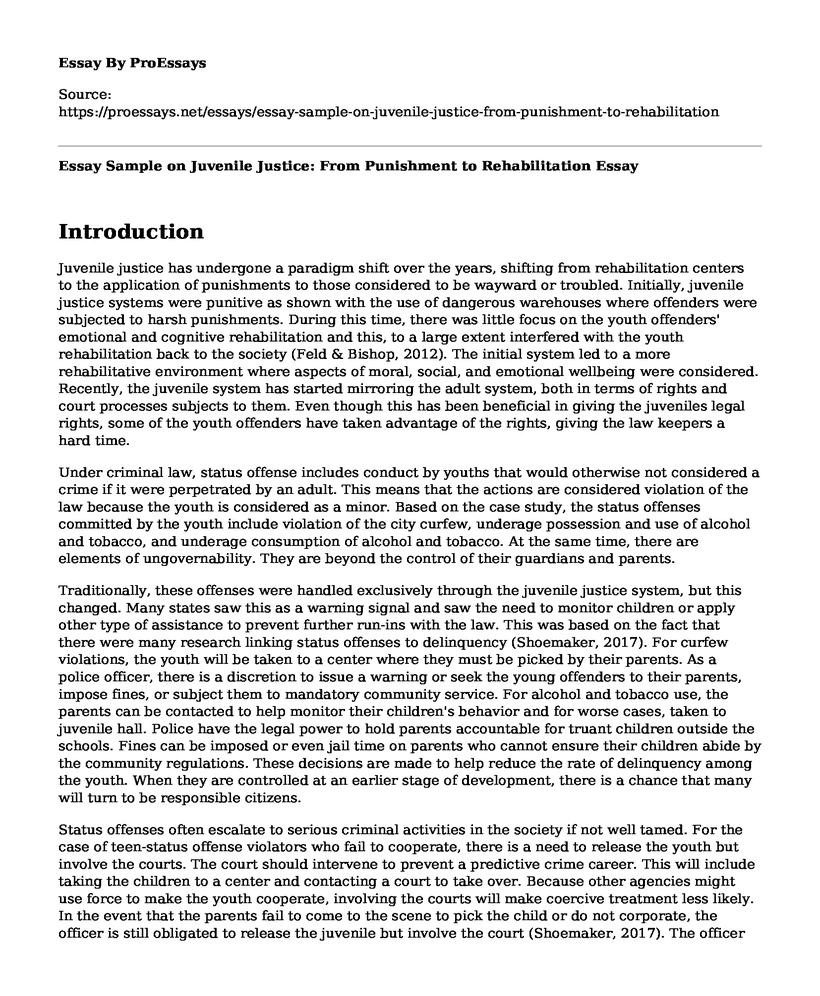Introduction
Juvenile justice has undergone a paradigm shift over the years, shifting from rehabilitation centers to the application of punishments to those considered to be wayward or troubled. Initially, juvenile justice systems were punitive as shown with the use of dangerous warehouses where offenders were subjected to harsh punishments. During this time, there was little focus on the youth offenders' emotional and cognitive rehabilitation and this, to a large extent interfered with the youth rehabilitation back to the society (Feld & Bishop, 2012). The initial system led to a more rehabilitative environment where aspects of moral, social, and emotional wellbeing were considered. Recently, the juvenile system has started mirroring the adult system, both in terms of rights and court processes subjects to them. Even though this has been beneficial in giving the juveniles legal rights, some of the youth offenders have taken advantage of the rights, giving the law keepers a hard time.
Under criminal law, status offense includes conduct by youths that would otherwise not considered a crime if it were perpetrated by an adult. This means that the actions are considered violation of the law because the youth is considered as a minor. Based on the case study, the status offenses committed by the youth include violation of the city curfew, underage possession and use of alcohol and tobacco, and underage consumption of alcohol and tobacco. At the same time, there are elements of ungovernability. They are beyond the control of their guardians and parents.
Traditionally, these offenses were handled exclusively through the juvenile justice system, but this changed. Many states saw this as a warning signal and saw the need to monitor children or apply other type of assistance to prevent further run-ins with the law. This was based on the fact that there were many research linking status offenses to delinquency (Shoemaker, 2017). For curfew violations, the youth will be taken to a center where they must be picked by their parents. As a police officer, there is a discretion to issue a warning or seek the young offenders to their parents, impose fines, or subject them to mandatory community service. For alcohol and tobacco use, the parents can be contacted to help monitor their children's behavior and for worse cases, taken to juvenile hall. Police have the legal power to hold parents accountable for truant children outside the schools. Fines can be imposed or even jail time on parents who cannot ensure their children abide by the community regulations. These decisions are made to help reduce the rate of delinquency among the youth. When they are controlled at an earlier stage of development, there is a chance that many will turn to be responsible citizens.
Status offenses often escalate to serious criminal activities in the society if not well tamed. For the case of teen-status offense violators who fail to cooperate, there is a need to release the youth but involve the courts. The court should intervene to prevent a predictive crime career. This will include taking the children to a center and contacting a court to take over. Because other agencies might use force to make the youth cooperate, involving the courts will make coercive treatment less likely. In the event that the parents fail to come to the scene to pick the child or do not corporate, the officer is still obligated to release the juvenile but involve the court (Shoemaker, 2017). The officer will make a notion of the refusal on the summons for further follow-up. In the end, a fine or jail term can be imposed on the parents.
Conclusion
In a nutshell, there have been significant changes in juvenile justice over the years. This is based on how the juvenile offenders were treated and how they are treated at the moment. The youth offenders now have legal rights which protects them from coercion and extortion. The law is clear on how adult offenders should be handled, but this is entirely different for youth offenders. This means that officers should control them carefully to avoid legal battles.
References
Feld, B. C., & Bishop, D. M. (2012). The Oxford handbook of juvenile crime and juvenile justice. Oxford: Oxford University Press.
Shoemaker, D. J. (2017). Delinquency. The Encyclopedia of Juvenile Delinquency and Justice, 1-5. Retrieved from https://doi.org/10.1002/9781118524275.ejdj0060
Cite this page
Essay Sample on Juvenile Justice: From Punishment to Rehabilitation. (2023, Feb 25). Retrieved from https://proessays.net/essays/essay-sample-on-juvenile-justice-from-punishment-to-rehabilitation
If you are the original author of this essay and no longer wish to have it published on the ProEssays website, please click below to request its removal:
- Broken Windows Theory
- Local Law Enforcement and Illegal Immigrants Essay
- Essay on Trump Admin's Stand on Legalizing Marijuana: Impact on the Nation
- Paper Example on Aryan Brotherhood
- Essay Sample on Rising Crime Rate: Punishment, Death Penalty, and Unpunished Crimes
- U.S. Prisons: Angola Louisiana State Correctional Facility - Essay Sample
- U.S. Constitution: Separation of Powers, Checks and Balances - Essay Sample







